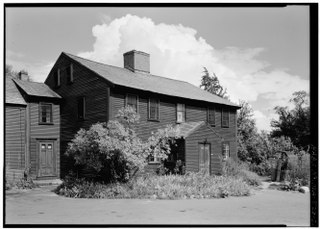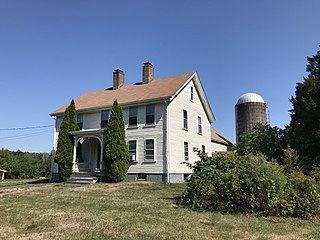
Minute Man National Historical Park commemorates the opening battle in the American Revolutionary War. It also includes the Wayside, home in turn to three noted American authors. The National Historical Park is under the jurisdiction of the National Park Service and protects 970 acres (392.5 ha) in and around the Massachusetts towns of Lexington, Lincoln, and Concord.

The Jason Russell House is a historic house in Arlington, Massachusetts, the site of the bloodiest fighting on the first day of the American Revolutionary War, April 19, 1775. The house was purchased in 1923 by the Arlington Historical Society which restored it in 1926, and now operates it as a museum from mid-April through the end of October, together with the adjoining Smith Museum, built in 1981 to house changing exhibitions of life in Arlington.

The Battles of Lexington and Concord was the first major military campaign of the American Revolutionary War, resulting in an American victory and outpouring of militia support for the anti-British cause. The battles were fought on April 19, 1775, in Middlesex County, Province of Massachusetts Bay, within the towns of Lexington, Concord, Lincoln, Menotomy, and Cambridge. They marked the outbreak of armed conflict between the Kingdom of Great Britain and Patriot militias from America's thirteen colonies.

North Billerica is an unincorporated village of the town of Billerica, Massachusetts, United States, one of the nine sections (hamlets) that make up the Town of Billerica. It is the home to Faulkner and Talbot mills and the North Billerica Train Depot. The Middlesex Canal was built through the village in 1783 and the Boston and Lowell Railroad was put through in the 1840s.

The Col. James Barrett Farm is a historic American Revolutionary War site in Concord, Massachusetts, associated with the revolution's first battle, the 1775 battles of Lexington and Concord. His farm was the storage site of all the town of Concord's militia gunpowder, weapons and two pairs of prized bronze cannons.

Battle Road, formerly known as the Old Concord Road and the Bay Road, is a historic road in Massachusetts, United States. It was formerly part of the main road connecting Lexington, Lincoln and Concord, three of the main towns involved in the American Revolutionary War. It was on Battle Road that thousands of colonial militia and British regulars fought during the redcoats' retreat from Concord to Boston on the morning and afternoon of April 19, 1775.
Capt. John Trull (1738–1797) was the commander of the Tewksbury, Massachusetts minuteman company on the first day of the American Revolution, at the Battle of Lexington & Concord.

Hartwell Tavern is a historic American Revolutionary War site associated with the revolution's first battle, the 1775 battles of Lexington and Concord. It is located on North County Road, just off Battle Road in Lincoln, Massachusetts, and is operated as a historic house museum by the National Park Service as part of the Minute Man National Historical Park. Built in 1733, in what was then Concord, it is staffed from Memorial Day weekend to October by park rangers dressed in colonial attire who offer programs daily.

The Samuel Hartwell House is a historic American Revolutionary War site associated with the revolution's first battle, the 1775 battles of Lexington and Concord. Built in 1733, in what was then Concord, it was located on North County Road, just off Battle Road in today's Lincoln, Massachusetts, and about 700 feet east of Hartwell Tavern, which Hartwell built for his son, Ephraim, and his newlywed wife, Elizabeth, in 1733. The site is part of today's Minute Man National Historic Park.

The Captain William Smith House is a historic American Revolutionary War site in Lincoln, Massachusetts, United States. Part of today's Minute Man National Historic Park, it is associated with the revolution's first battle, the 1775 battles of Lexington and Concord. Believed to have been built in 1692, in what was then Concord, it is believed to be the oldest house in Lincoln.

The Job Brooks House is a historic American Revolutionary War site in Lincoln, Massachusetts, United States. It is part of today's Minute Man National Historic Park.

The Jacob Whittemore House is a historic American Revolutionary War site in Lexington, Massachusetts, United States. It is part of today's Minute Man National Historic Park. It is located on Airport Road, just off Battle Road. It is the only house of the "witness" houses of the April 19, 1775 battles of Lexington and Concord to fall inside the Lexington town line; the others are in Lincoln or Concord.

The Samuel Brooks House is a historic American Revolutionary War site in Concord, Massachusetts, United States. It is part of today's Minute Man National Historic Park. It is located on North Great Road, just off Battle Road.
The Bloody Angle refers to a section of the Battle Road, in Lincoln, Massachusetts, on which two battles were fought on April 19, 1775, during the battles of Lexington and Concord, in the first stage of the American Revolutionary War. The road runs east–west, but turns north for about 500 yards (460 m) and then east again, as per the direction of travel during the British regulars' retreat from nearby Concord to Boston.

The Farwell Jones House is a historic American Revolutionary War site associated with the revolution's first battle, the 1775 battles of Lexington and Concord. Built in the early 18th century, it stands on Lexington Road in Concord, Massachusetts, just southwest of the former Battle Road. It is one of eleven houses within the Minute Man National Historic Park that still exists today.

The Stow-Hardy House is a historic American Revolutionary War site associated with the revolution's first battle, the 1775 battles of Lexington and Concord. It stands, on the site of a previous home built around 1689, on Lexington Road in Concord, Massachusetts, just southwest of the former Battle Road. It is one of eleven houses within the Minute Man National Historic Park that still exists today.

The Noah Brooks Tavern is a historic American Revolutionary War site associated with the revolution's first battle, the 1775 battles of Lexington and Concord. It stands, on the site of a previous home, on North Great Road in Lincoln, Massachusetts, just south of the former Battle Road, in an area known as Brooks Village. It is one of eleven houses within the Minute Man National Historic Park that still exists today.
Brooks Hill is a historic American Revolutionary War site associated with the revolution's first battle, the 1775 battles of Lexington and Concord. It was here, beside the Battle Road, that the British regulars passed on their marches to Concord from Boston, and again on their retreat east. It has also been referred to as Hardy's Hill.

Meriam's Corner is a historic American Revolutionary War site associated with the revolution's first battle, the 1775 battles of Lexington and Concord. It is located, on the former Battle Road, at the junction of today's Lexington Road and Old Bedford Road in Concord, Massachusetts, and is named for the Meriam family, who lived there. The Nathan Meriam House still stands beside Old Bedford Road and forms part of Meriam's Corner itself. Both the house and Meriam's Corner are part of the Minute Man National Historic Park. Three of the Meriam family's homes stood here in 1775, the other two belonging to Josiah Meriam, brother of Nathan, and their nephew John.
William Smith was a captain of the minutemen of Lincoln, Province of Massachusetts Bay, during the battles of Lexington and Concord, which began the American Revolutionary War.
















